Like the wind plays with leafage, feelings flow from leaf to leaf, from branch to branch – burning like fire, shining and sounding as an inexpressible heartfelt song, the Song of God! Plunging deeper and deeper into the boundless well of feelings! Guards of the Animal Nature are on the alert, endeavouring to steal HUMAN attention, but if you are consistent and have made your choice, you will certainly be rewarded with DIVINE HAPPINESS signifying LIFE.
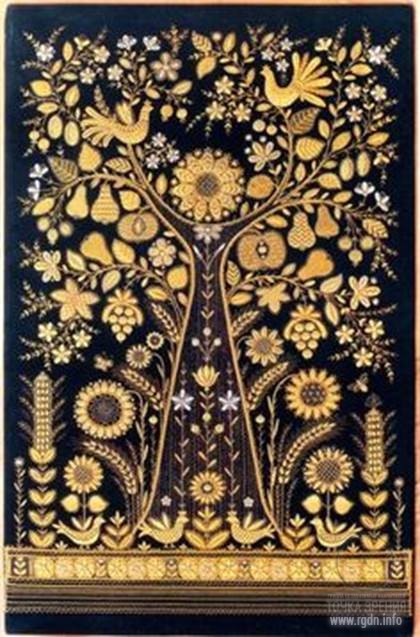 Every nation has had its sacred tree with its peculiarities and features based on natural and sometimes occult qualities, as esoteric teachings suggest. Thus, Ashvattha, the sacred tree in India, the abode of Pitri, turned into Bodhi tree (or ficus religiosa) of Buddhists all over the world, since Gautama Buddha achieved enlightenment and Nirvana under this very tree. The ash tree – Yggdrasil – serves as the world tree for Scandinavians. There is also Banyan – the symbol of spirit and matter, descending to the earth, taking roots and then rising to the heaven again. Palasa with triple leaves is a symbol of the triple essence in the universe: Spirit, Soul, and Matter. A black cypress was the world tree in Mexico, while now it is a symbol of death, peace and calmness for Christians and Mohammedans. Abies was considered sacred in Egypt, and its cones were carried during religious processions, although now it has almost disappeared from the Land of Mummies. Sycamore, tamarisk, palm, and grapevine were also regarded as sacred. Sycamore was the Tree of Life in Egypt and Assyria. It was dedicated to goddess Hathor in Heliopolis, whereas now in the same place it is dedicated to Virgin Mary. Its sap was precious owing to the quality of its occult powers, just like Soma for Brahmans and Haoma for Parsees. “The fruit and sap of the Tree of Life grant immortality.” In Erzya beliefs the tree is called Echke Tumo, on which there is a nest of the sacred duck Ine Narmun giving birth to the egg from which the entire world emerges. In Turkic myths the tree is called Baiterek; with its roots it holds the earth in its place, while its branches support the sky so that it would not fall. It is the Mecabziel tree in Kabbalah, and Sidrat al-Muntahā in the Quran. In China it is Kien-Mu along which the Sun and the Moon, sovereigns, sages, Gods, spirits, etc. descend. It would be possible to write a whole big book on the ancient sacred trees, some of which are revered until today, nonetheless the subject would never be fully covered.
Every nation has had its sacred tree with its peculiarities and features based on natural and sometimes occult qualities, as esoteric teachings suggest. Thus, Ashvattha, the sacred tree in India, the abode of Pitri, turned into Bodhi tree (or ficus religiosa) of Buddhists all over the world, since Gautama Buddha achieved enlightenment and Nirvana under this very tree. The ash tree – Yggdrasil – serves as the world tree for Scandinavians. There is also Banyan – the symbol of spirit and matter, descending to the earth, taking roots and then rising to the heaven again. Palasa with triple leaves is a symbol of the triple essence in the universe: Spirit, Soul, and Matter. A black cypress was the world tree in Mexico, while now it is a symbol of death, peace and calmness for Christians and Mohammedans. Abies was considered sacred in Egypt, and its cones were carried during religious processions, although now it has almost disappeared from the Land of Mummies. Sycamore, tamarisk, palm, and grapevine were also regarded as sacred. Sycamore was the Tree of Life in Egypt and Assyria. It was dedicated to goddess Hathor in Heliopolis, whereas now in the same place it is dedicated to Virgin Mary. Its sap was precious owing to the quality of its occult powers, just like Soma for Brahmans and Haoma for Parsees. “The fruit and sap of the Tree of Life grant immortality.” In Erzya beliefs the tree is called Echke Tumo, on which there is a nest of the sacred duck Ine Narmun giving birth to the egg from which the entire world emerges. In Turkic myths the tree is called Baiterek; with its roots it holds the earth in its place, while its branches support the sky so that it would not fall. It is the Mecabziel tree in Kabbalah, and Sidrat al-Muntahā in the Quran. In China it is Kien-Mu along which the Sun and the Moon, sovereigns, sages, Gods, spirits, etc. descend. It would be possible to write a whole big book on the ancient sacred trees, some of which are revered until today, nonetheless the subject would never be fully covered.
Ancient Egyptians believed that the world axis was a giant golden tree, the summit of which rested against the sky. On its upper branches precious stones grow and the goddess Nut lives. The rain that washes the earth and penetrates the underworld as surface waters takes place because the magic bird Phoenix hits branches of the golden tree with its wings, and the tree splashes its life-giving moisture. The World Tree worship was closely connected with the cult of Osiris, he god of fertility and perpetual renewal of nature. Near his tomb there grew a tree on which, as ancient Egyptians believed, the god’s soul was sitting as a bird. According to ancient Egyptian images, this mythical tree grows through Osiris’s entire tomb, braiding it with its roots and branches. Moreover, this tree was often identified with Osiris himself.
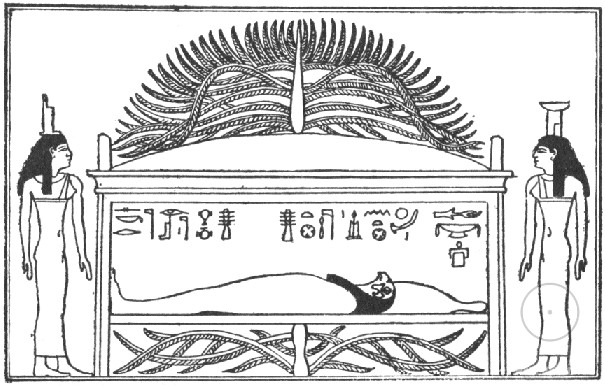
Just like the Hindus and other ancient peoples, ancient Egyptians believed that the earthly tree they revered was a copy of the heavenly tree growing in the higher world. The Phoenicians (another ancient people of the Near East, who inhabited the Palestine coast) imagined the universe as a giant marquee supported by a huge tree standing in its centre and holding the firmament.
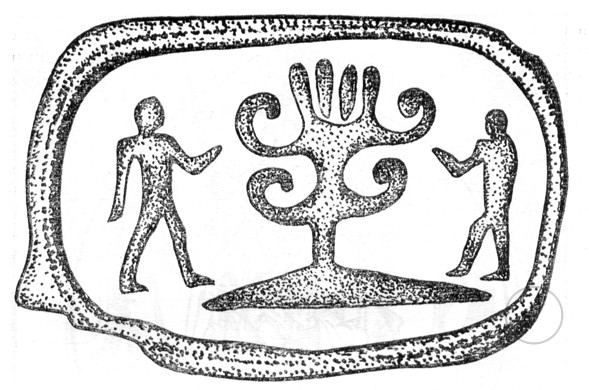
The ancient Chinese were also sure of the cosmic tree existence. According to their myths, the tree is located far in the east, in the Valley of Light. In that very place a colossal mulberry of an unembraceable thickness rose from the seething sea. On its very top a magic cock was sitting and heralded the beginning of the day with its shriek, forcing all evil spirits hastily go back where they came from. On the mulberry branches there were ten suns that looked like golden three-fingered ravens. Another world tree was located in the extreme west of the universe. Its leaves were like stars and illumined the world at night. For many centuries mythology has been developing: some plots and images got forgotten, while new ones emerged and covered the old ones. Therefore, besides the two aforesaid cosmic trees Chinese myths mention many other trees, similar to those two. Thus, there are myths dedicated to an enormous, extremely high tree Syun, as well as to the magic breadfruit tree of five girths in thickness, growing on the world mountain Kunlun; in that place there are miraculous springs and all gods of the Celestial Empire residing. Myths also mention trees on which one can ascend to the heaven and descend to the underworld – it’s the road of gods and shamans.
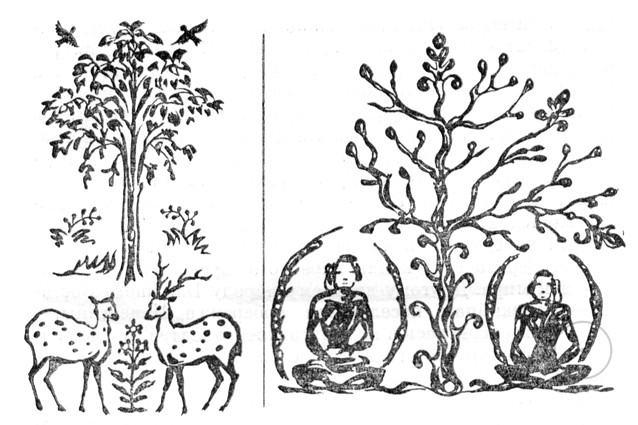
Maya Indians in Central America also placed the fantastic Primary World Tree in the middle of the universe and depicted it with a barrel-shaped trunk covered with thorns. That very tree was believed to be supporting the universe. Furthermore, there existed four other sacred trees located at the four corners of the world, which were supposed to serve as additional pillars. However, the central tree remained the main one, since, first and foremost, gods gathered around it in the very middle of the universe to solve the most important issues relating to the destiny of people and the universe. The great World Tree cult ran through many fields of Mayan religious life. Numerous images of the tree are found in Maya manuscripts and on their stone bas-reliefs. Its paramount importance is evidenced at least by the fact that the altar on which sacrificial offerings were made had a shape of the sacred tree stump. According to Maya beliefs, since the tree ties all worlds of the universe, a sacrifice easily gets to the heaven via it and is more pleasing to gods.
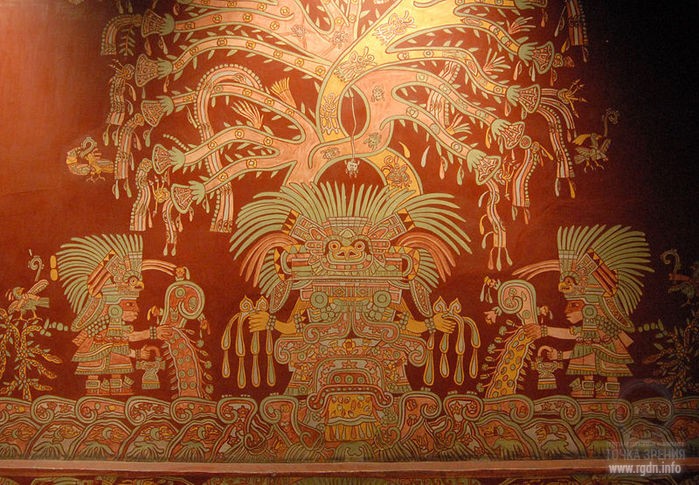
A very special role is played by the World Tree in archaic shaman religions, where this image is developed in the most detailed way. Yakut myths devoted much attention to the miraculous tree Aal Luuk Mas, supposedly growing in the middle of Siberian land. Legends say the tree sheds the life-giving moisture Ilge that gives cheerfulness and extra force to those who drink it. Once upon a time this tree intended to germinate to the heavenly land of higher spirits in order to destroy them, but eventually it rejected the sacrilegious idea and turned into a tethering post for the heavenly beings after it reached the heaven. Other time, having decided to reach to the underworld and destroy lower spirits, the tree changed its mind again, and its roots started serving as a hanger for the underworld beings. Stretching high upwards and deep downwards, Aal Luuk Mas represents a steadfast core of the universe.
According to Altaic beliefs, in a blissful place where seventy rivers flow together, a hundred-barrelled seven-node eternal poplar with golden and silver leaves towers. A whole herd of horses can hide under a single branch of this fantastic tree. Two golden cuckoos are sitting on its top, heralding destinies, and wonderful flowers blossom of their singing all over the earth. On its middle branches there are two black eagles with diamond claws, carefully guarding the depth of the blue sky. Two terrible dogs with bloodshot eyes are chained to the poplar base. Near the poplar a magic horse peacefully pastures, which may be possessed by a great hero only.
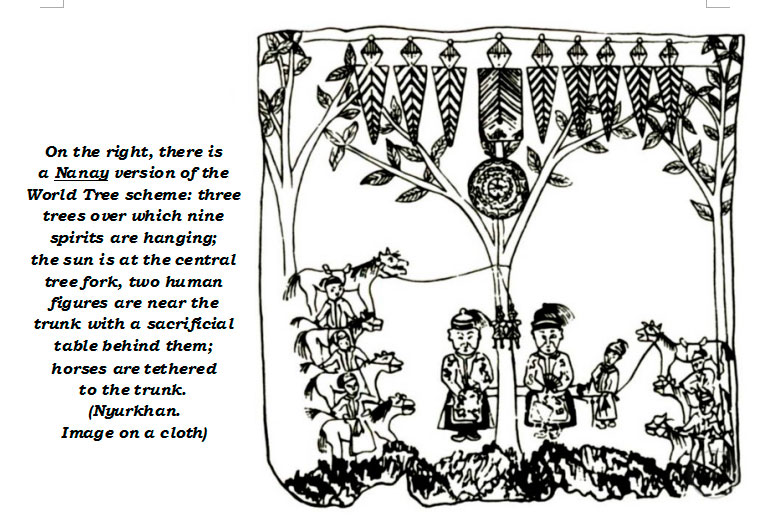
The World Tree is an indispensable attribute of the shaman worldview and cult. Shamans were believed to possess many supernatural abilities, and one of their most significant abilities was that they could travel to other worlds to gods and spirits. They did this for various purposes, but most often to get back the soul of an ill person, which as they believed was stolen by spirits, or to ask the spirits why they inflicted one or another trouble on people. Preparing for such a journey, a shaman drove himself into a state of sacred ecstasy. To achieve such state, he beat the tambourine and danced, spinning on a single spot. Consequently his spirits-helpers arrived, and he started on a journey with them. Then the World Tree played a key role, for the shaman made his way to the heaven or to the underworld via that tree. With the help of his friendly spirits the shaman climbed upwards, or vice versa descended to the tree roots, getting into the other worlds.
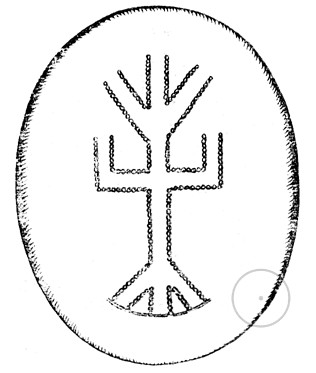
The World Tree (Evenks)
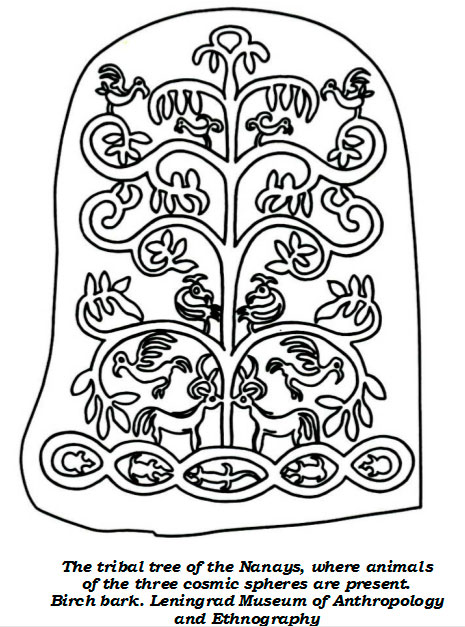
All the aforesaid helps to understand why the World Tree is frequently called the Shaman Tree. For shamans it not only served as a sacred road, but was considered their cradle as well. Legends say, on twigs of the tree there are nests, similar to bird’s nests and placed one above the other, where souls of all future shamans are being brought up. The higher a nest is the stronger shaman will be born there. The “spirit charmers” described themselves as follows: “I am the shaman of the fourth twig”, “He is the shaman of the seventh twig”, and so on. Ritual substitutes for the World Tree played a great role in shaman rites. A special tree was often placed in front of shaman yurts. When a tested person was consecrated shaman, he climbed up the tree, which symbolized his ascent to the heaven. A special sacred tree was also selected as a shaman burial place: this way he could more easily reach the heaven in order to reincarnate as another person.
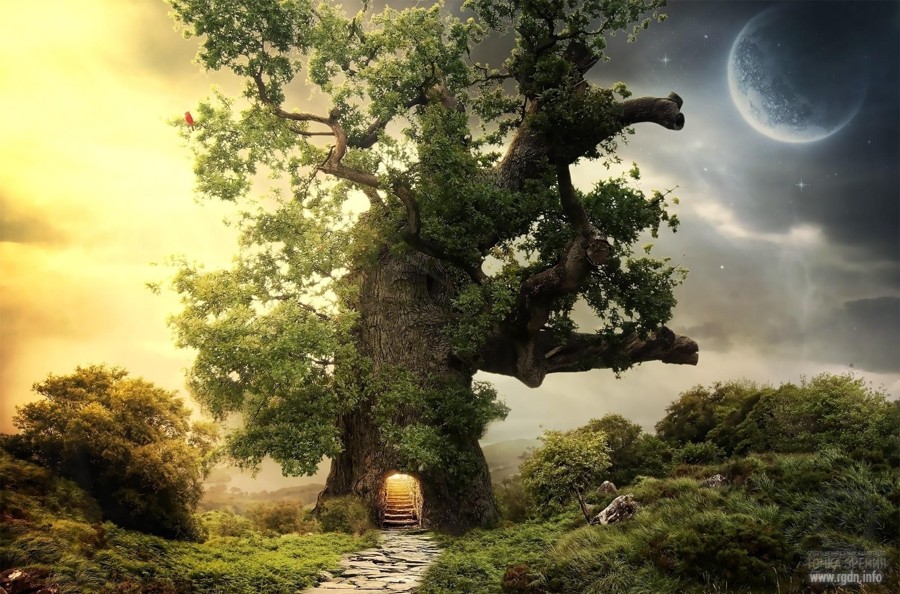
Besides binding of the worlds together, a major function of the World Tree was to embody the idea of fertility in a concentrated form. Entreaty of fertility is the main content of many religious rites and beliefs: people asked gods to send them more food, game, cereals, moisture for good harvests, and so on. The above information indicates all that is abundantly available under the magic World Tree. In that place vivifying springs run, giving power and immortality, diverse plants and fruits luxuriantly grow, and various animals peacefully pasture. Moreover, the cosmic tree not just embodies the abundance of food, but grants children as well. There are numerous myths in which human souls grow on this tree as flowers or fruits. Falling down to the mother’s womb, they become a cause of childbirth. In fairy tales such ideas have been remade: a magic wand appeared which initially represented a branch of the miraculous tree. By its single touch one can work diverse miracles: retrieve water in a desert, turn a stone into gold, or revive a dead person.
Totally logically, gods, heroes and great kings are born under the World Tree in the middle of the universe. An ancient Greek myth says that little Zeus was nursed by the nanny goat Amalthea at the foot of the sacred tree. Apollo – another great deity of Ancient Greece – was also born under the tree. Legends say, the Babylonian king Nebuchadnezzar was found under a tree when he was a little baby. Buddha’s mother Maya was walking in the garden when she felt birth pangs starting, and she gave birth to the “redeemer of all living creatures”, holding a branch of one of trees. Y Yin, the legendary adviser of one of the great kings of Ancient China, was supposedly found in a hollow of a mulberry tree, which as we know was revered by the Chinese as the World Tree. According to a legend, Genghis Khan was found in a steppe when he was sucking leaves of an isolated miraculous tree. Finally, apocryphal Christian legends tell almost the same about Jesus Christ. The Gospel of Pseudo-Matthew mentions that Archangel Gabriel brought the news of the immaculate conception to Mary when she was drawing water from a spring at the foot of a tree.

The Tree of Knowledge mentioned in the Book of Genesis is apparently the World Tree referred to in myths of many peoples. The Old Testament describes it quite vividly, and many details are added by the later Talmudic and apocryphal legends. Some legends say the tree from which Adam and Eve enjoyed the fruit was a vine tree, because nothing brings more evil than wine. Other legends say it was a fig tree of leaves of which the primogenitors supposedly sewed clothes for themselves. Still others mention it was wheat or a breadfruit tree, since, as the Babylonian Talmud explains, no child can call either the father or the mother before tasting bread, therefore the Old Testament tells about the Tree of Knowledge. Moreover, the Book of Genesis mentions another heavenly tree – the Tree of Life (which is obviously a mere duplicate of the Tree of Knowledge). According to the Talmud, the tree has truly cosmic dimensions: one would need 500 years only to go round it.
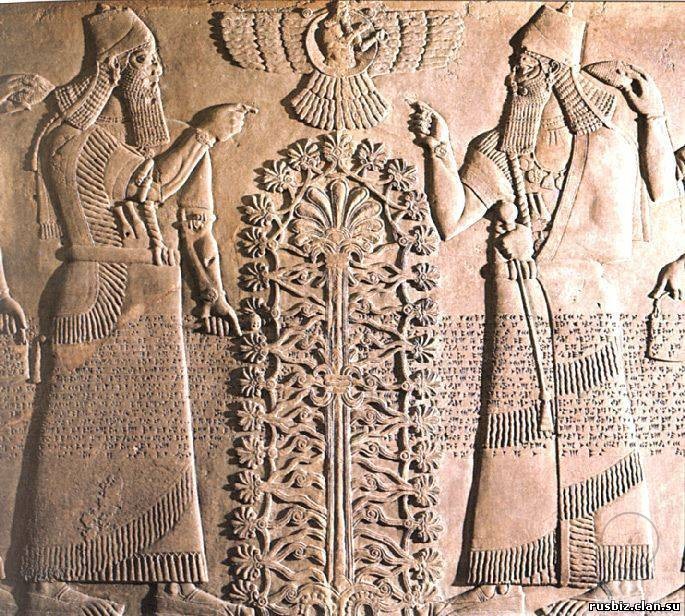
The World Tree in Zoroastrianism
According to Bhagavad Gita, the Tree of Life and Existence, destruction of which is the only way to immortality, grows with its roots upwards and its branches downwards. The roots symbolize the Superior Essence or the Origin, Logos; but one should soar beyond the roots in order to merge with Krishna who, as Arjuna says, is “higher than Brahman, and the Origin… the Everlasting! You are Existence and Non-Existence, Unspeakable is That what is beyond them”. The tree branches are Hiraṇyagarbha, the highest Dhian Kohans or Devas. The Vedas are its leaves. Only the one who has risen above the roots, will never return, i.e. will never be incarnated again during this Age of Brahma.
The most famous World Tree is surely Yggdrasil – the giant ash tree of Scandinavian mythology, being the axis, the structural basis of the world, the tree of life and destiny. Descriptions of Yggdrasil, “the tree of the best”, are available in numerous ancient Scandinavian texts, firstly in the Poetic (Elder) Edda and the Prose (Younger) Edda. Sometimes the descriptions are different, but ultimately they form a mythic description of the entire universe, as Scandinavians understood it.
An Ash I know called Yggdrasil,
A tall tree sprinkled with white waters:
Thence come the dews that fall in the dales.Evergreen it always stands above Urd’s Well.
(Prophecy of the Seeress. Poetic Edda)
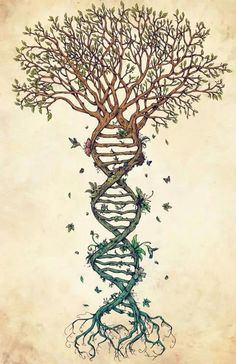 Yggdrasil joins all worlds: the world of gods (Asgard), the world of people and giants, and the underworld – the kingdom of the dead. Near its three roots, which are incessantly gnawed by snakes and dragon Nidhogg, there are three springs: Mimira, Urd and the Boiling Kettle (Hvergelmir). The honeydew spring Mimira, “in which knowledge and wisdom are concealed”, nourishes the World Tree with honey. The whole Yggdrasil is saturated with the life-giving honey. In the Urd spring, the name of which means Destiny or Fate, three virgins reside: the first one is also named Destiny (Urd), the second one is named Verdandi (Formation), and the third one’s name is Okuld (Duty, Commitment). Their names simultaneously signify the inevitability of time flow: Urd means “implemented, past time”, Verdandi means the present, and Okuld means the inevitable future. These are the Virgins of Destiny or Norns, similar to Greek Moirai. Other numerous similar female deities or spirits that are also called Norns or Disas come to every newborn baby and endow him or her with a destiny – good or bad one, depending on the deity’s character. They originate from different mythical creatures: some from deities, others from dwarfs (tsvergs), stills other from alfs – the spirits of nature, whose name resembles of elfs and fairies from European tales and legends. At that, main Norns determine the destiny of the whole world, implementing its past, present and future. Their origin is mysterious just as many things dating from the beginning of times. The World Tree that grows near the Norn spring not just joins all worlds in a mythological space, but binds together the past and the future. The mythic time – the time measured by alteration of days and nights, by celestial bodies moving along the firmament in their chariots – seems to be indifferent to destinies of the world and humanity. It’s the time of cosmic cycles, the time of eternal reiteration.
Yggdrasil joins all worlds: the world of gods (Asgard), the world of people and giants, and the underworld – the kingdom of the dead. Near its three roots, which are incessantly gnawed by snakes and dragon Nidhogg, there are three springs: Mimira, Urd and the Boiling Kettle (Hvergelmir). The honeydew spring Mimira, “in which knowledge and wisdom are concealed”, nourishes the World Tree with honey. The whole Yggdrasil is saturated with the life-giving honey. In the Urd spring, the name of which means Destiny or Fate, three virgins reside: the first one is also named Destiny (Urd), the second one is named Verdandi (Formation), and the third one’s name is Okuld (Duty, Commitment). Their names simultaneously signify the inevitability of time flow: Urd means “implemented, past time”, Verdandi means the present, and Okuld means the inevitable future. These are the Virgins of Destiny or Norns, similar to Greek Moirai. Other numerous similar female deities or spirits that are also called Norns or Disas come to every newborn baby and endow him or her with a destiny – good or bad one, depending on the deity’s character. They originate from different mythical creatures: some from deities, others from dwarfs (tsvergs), stills other from alfs – the spirits of nature, whose name resembles of elfs and fairies from European tales and legends. At that, main Norns determine the destiny of the whole world, implementing its past, present and future. Their origin is mysterious just as many things dating from the beginning of times. The World Tree that grows near the Norn spring not just joins all worlds in a mythological space, but binds together the past and the future. The mythic time – the time measured by alteration of days and nights, by celestial bodies moving along the firmament in their chariots – seems to be indifferent to destinies of the world and humanity. It’s the time of cosmic cycles, the time of eternal reiteration.
According to beliefs of many peoples, the souls of yet unborn babies reside on branches of the World Tree. The Tree of Destiny used to be a genealogical tree as well. In his song The Loss of the Sons the Icelandic scald Egil Skallagrimsson compares the dead son with an ash tree grown from his family and his wife’s family and taken by Gaut-Odin to the world of gods – to his dear souls. Dead people returned to the world of their ancestors, to the World Tree. Destinies of all beings are determined at the World Tree, and embodiments of all worlds gather at its trunk, crown and roots. A big wise donkey lives in its branches with a hawk sitting between its eyes. Squirrel Gryzozub bustles up and down on its trunk, carrying pejoratives exchanged by dragon Nidhogg and the eagle. Four deer eat its leaves round, and the Poetic Edda further mentions numerous snakes gnawing the tree roots together with Nidhogg, whereas the ash trunk is subject to decay. Hence, Norns must water the ash tree from the Urd spring every day and even fertilize it, taking the water together with mud that covers the banks. The water in the spring is sacred: whatever gets into the water turns white. It is so vivifying that the ash tree remains evergreen. “The Tree of Life is evergreen,” Goethe wrote in his Faust, continuing the ancient German tradition.
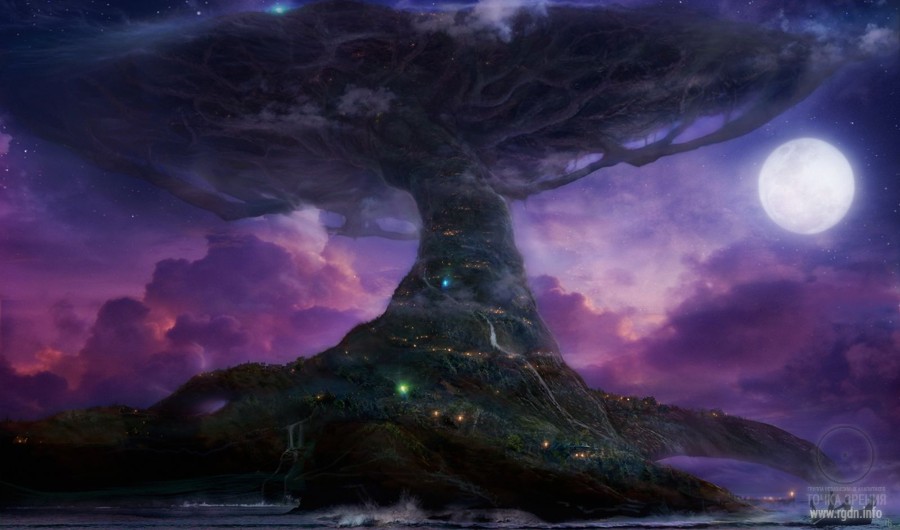
The dew streaming from Yggdrasil down to the ground is honeydew; bees eat it and gather nectar. Two marvellous swans are swimming in the spring. Swans are magic birds, which Valkyries, the divine virgins and Odin’s companions, loved to turn into. At that, the whole bestiary (animal world) connected with the World Tree embodies all spheres of the universe and correlation thereof: the eagle (and the hawk) dwell in the skies, but seek prey on the earth; the dragon is an underworld beast, but it can reach the sky owing to its wings; the swans are waterfowls; the four deer also embody the four cardinal directions, just like the dwarfs sitting at the ends of the earth.
The “Tree of the Limit”, growing in the middle of the universe and joining all worlds according to Scandinavian myths, with its crown reaches Valhalla – the palace of Odin, located in the divine city of Asgard. Here we begin to understand why Asgard is simultaneously in the heaven and in the middle of the world: it is pierced by the World Tree. In Valhalla it is called Lepad – the Shelter. On Valhalla roof the nanny goat Heidrun stands and browses leaves of the ash tree, therefore from its udder heady honey streams and fills a big jug, from where all those feasting in Odin’s hall have enough to drink every day. Yggdrasil is indeed the honeydew Tree of Life, nourishing with a magic drink. Near Valhalla gates in Asgard, a whole grove of magic trees grow. It is called Glasir – the Shining, because all leaves on the trees are made of red gold. Besides the nanny goat, deer Eikturnir “with oak horn tips” stands on Valhalla roof; it also eats leaves, and so much moisture drips from its horns that is streams down and fills the Boiling Kettle from which twelve terrestrial rivers originate. Deer is a sacred animal associated with the World Tree in many different mythologies of the world. Such link struck the eyes of ancient myths authors not only because deer ate tree leaves, but also because their horns themselves resembled a tree. It is no mere chance that “oak horn tips” were attributed to Eikturnir’s horns: we may assume the deer itself in the lost German myth played a role of the World Tree, since all terrestrial waters sprang from its horns. The later Icelandic Song of the Sun, which was written in the Christian age, though in heathen scald poetic traditions, mentions a solar deer whose legs stood on the earth and horns touched the sky. Gods (aces) gather near Yggdrasil to pass judgements, and supreme god Odin tethers his eight-legged horse Sleipnir to the tree trunk.
The World Serpent Jörmungandr was born when the creation was already completed. The evil ace Loki became the father of this and other monsters that will attack Asgard at the end of times and exterminate ancient enemies. The serpent has grown so enormous that it could find enough room for itself only in the world ocean where it encircles the earth, biting its own tail. For this reason it is called Midgarsom – the Midgard Serpent, or the Belt of the World. But it also has another name – Jörmungandr, meaning “the great crosier”.
Helena Blavatsky in Isis Unveiled, V. 1, Chapter 5, mentions that the Egyptian pyramids also symbolically represent the same idea of the World Tree. A pyramid summit is a mystical link between the heaven and earth, symbolizing the root, whereas the foundation is its spreading branches, stretching towards the four cardinal points of the material universe. The pyramid communicates the idea that all things in existence originated from the spirit.
Ancient people believed the Tree of Life was closely connected with the human Front Aspect, e.g. the Assyrians often depicted the unicorn (the Front Aspect symbol) near the Tree of Life.
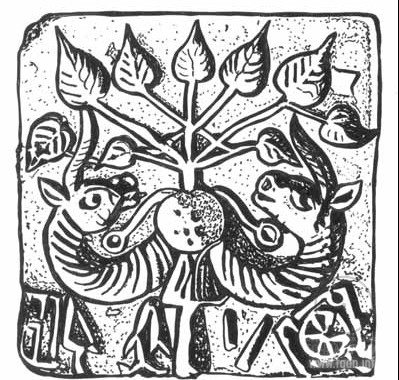
A unicorn symbol on a seal of proto-Hindu peoples
Let me cite a quote from the AllatRa book by Anastasia Novykh:
Rigden: Since ancient times, a unicorn has been one of the symbols of the Front Aspect that helps a spiritually pure person connect with his or her Soul and abandon the circle of rebirths. It personified aspiration in only one direction – the spiritual one; that is why it was endowed with qualities typical for a person in the course of one’s spiritual development: purity, honour, wisdom, strength, courage, and good deeds; it was also associated with the powers of Allat, the divine purity of the feminine principle (myths of the Virgin and the unicorn).
If we trace the history of the symbols, we will see that, for example, Sumerians placed the unicorn image as a symbol associated with the circle (the Soul), which is interpreted by researchers as a “lunar symbol” as well as an attribute of goddesses in the meaning of spiritual purity. Assyrians depicted the unicorn on bas-reliefs next to the Tree of Life, and Egyptians put the best moral qualities in its image. Persians, according to their sacred knowledge, regarded the unicorn as perfection, a representative of the “pure world” among animals (originally the four animals), and its horn as the only force capable of defeating Ariman. Or let us take Old Slavic legends and epic tales recorded in the ancient Russian collection of spiritual songs called The Pigeon Book (the book that got banned by religious ministers in the 13th century), in which the unicorn is referred to as Indrik-Beast (Indra). It contains the following lines:
“Our Indrik-Beast is the main beast,
And he goes, the beast, in the dungeons,
He crosses all the mountains of white stone
And clears all the creeks and streams.
When this beast leaps in joy,
The entire Universe stirs up.
All other beasts bow to this one beast,
And he never hurts anyone.”
Furthermore:
Rigden: Besides, Indra is believed to be the Guardian of one of the four cardinal directions. There is also a reference related to the Knowledge about the structure of the world, in particular that Indra rules over Svarga (Heaven); according to beliefs of the Hindus, it is a paradise located on the top of MountMeru. Now let’s recall that in the Slavic and Russian mythology there was also god Svarog – the god of Heaven, heavenly fire, the father of Dajdbog and Svarozhich. In The Tale of Bygone Years, the all-Russian chronicle of the beginning of the 12th century, which was included in the Hypatian Codex, the following mentions of it have been preserved: “...сего ради прозваша и богъ Сварогъ... и по семь царствова сынъ его именемъ Солнце, его же наричють Дажьбогъ... Солнце царь, сынъ Свароговъ, еже есть Дажьбогъ...” (“...for this cause, he was called god Svarog ... and his son under the name of the Sun ruled over seven kingdoms. He was named Dajdbog ... The king of the Sun, Svarog’s son, he is Dajdbog...”).
Anastasia: That’s right, all this has one and the same root! After all, although allegorically, but it speaks of seven dimensions and of human spiritual self-improvement work. Svarog, for example, being the embodiment of heaven, according to the epics, “in the darkness of thunderclouds kindled the flame of the heavenly fire (lightning).” Then, “breaking rain clouds with thunderbolts, he kindled the lamp of the sun extinguished by the demons of darkness.” If we consider that Svarog acts as the Front Aspect here, the rain clouds are thoughts from the Animal Nature, and the lamp is the Soul “extinguished by the darkness” of subpersonalities, then the Old Russian mythology looks quite interesting.
Rigden: You bet... Incidentally, The Pigeon Book, which explains the origin of the world, also mentions the Alatyr Stone. According to the legend, it is believed to have signs inscribed upon it that “speak” of the laws of Svarog, the god of heaven. According to Old Russian legends, it is from under the Alatyr Stone that the sources of living water begin and carry sustenance and healing (creation); it is beneath this stone that the power that has no end is hidden, and it is on the Alatyr Stone that fair maiden Dawn sits, who always wakes the world up from the night sleep. Now, match all this with the knowledge of the AllatRa sign, of the power of the divine generative feminine principle Allat and its important role both in the processes of the Universe development and in the spiritual awakening of the Personality and its fusion with the Soul. Incidentally, in their spiritual tales from the old times, Allatyr is what the Slavic ancestors called the power of Allat emanating from God as well as the person who has accumulated this power and increased it in oneself via spiritual labour.
Ancient Slavs believed the World Tree was on the Alatyr Stone on the BuyanIsland, in the middle of the universe. Healing magic rivers spread from under the Alatyr Stone across the world. Alatyr is guarded by the wise snake Garafena and the bird Gagana.
In my opinion, it is easy to identify the etymology of the word Alatyr: тырить (to steal, to accumulate). Hence, Alatyr means “one who has accumulated (is accumulating) Allat! The same etymology is that if the word BogaTyr (“the powerful”) – “one who steals (accumulates) God, accumulates (gains) the Holy Spirit. Unfortunately, contemporary philologists interpret this word as богатый (rich), voivode or even violent, thinking this word is Turkic or Mongolian by origin, although its true meaning is clearly understandable!!
The tree image has reached us via diverse fairy tales, epic stories, charms, songs, riddles, as well as via ritual embroideries on clothes, patterns, tableware, coffers, etc. Here is an example of how the World Tree is described in one of Slavic folk tales popular in Rus and telling about a bogatyr-hero obtaining a horse: “...there is a copper pillar to which a horse is tethered; pure stars are on the horse’s body sides, a crescent shines on its tail, and a red sun shines on its forehead...” This horse is a mythical symbol of the entire universe, being still tied to a central pillar or tree.
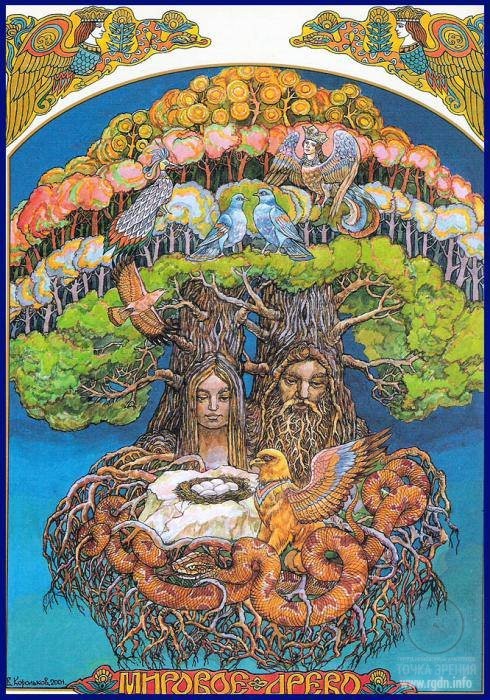
Let me cite another extract from the AllatRa book by Anastasia Novykh:
Rigden: This is exactly so. The icon of Our Lady of the Burning Bush (Neopalimaya Kupina) has nothing to do with all these affairs of priesthood. In Rus it started to be called so not of the word купина (kupina) meaning “bush”, “blackthorn”, or “shrub”, but of the Old Slavonic word купа, which means a “connection”, “elevation”, an “aggregate of something”. As for the fact that it got associated with the superstition of protection against fire… well, at least now it is, as you have correctly noticed, found in every home, after becoming famous for working miracles. But what is more important is that the knowledge has been passed through it to the majority, even in such a “sealed form”. The knowledge is available now, and this is by no means unimportant!
It is no coincidence that Our Lady of the Burning Bush (Neopalimaya Kupina) is associated with the symbol of the immaculate conception from the Holy Spirit. It is exactly a symbol of what I told you about. God’s Mother is a conductor of the power of God for every person who follows the spiritual path; it is the power of God’s love by means of which a human Soul is liberated from earthly incarnations. Jesus as a Spiritual Being from the other world updated the true Knowledge lost in centuries and gave people spiritual tools for spiritual salvation. In other words, he left the keys. Working on oneself with these tools, a person acquired, figuratively speaking, a key to the sign. At that, He gave power and signs themselves to God’s Mother as to a conductor of God’s power, as to a spiritually liberated Being residing between the worlds for the sake of spiritual liberation of human souls. And it is only when diligence and self-improvement work of a spiritual seeker and the power of God’s Mother (Allat) were connected that the Personality merged with the Soul, that is, a person attained liberation of his or her Soul, the seventh dimension or, as they say in Christianity, “paradise”, “the kingdom of the Father and of the Son.” And it only depended on the choice of a person whether the sign would be active and whether the person would be Worthy of receiving this divine power that would lead him or her to God. The key is given for the purpose of being used, and in order to use the key it is necessary to invest one’s effort. Such is the way of a spiritual person – the way of spiritual dispassionateness, which, only when combined with the creating power of God, leads to liberation.
This is known not only in Christianity, but in other religions as well. This was known already in the ancient times when people had different names for God, His Son, and God’s Mother (the Great Mother). After all, it is not about priestly conceptions from the mind and their epithets, but about one and the same spiritual grains on which all their religions are held. Let me give a simple example.
As I have mentioned, not too long ago the cult of goddess Isis, which originated in ancient Egypt, used to be very popular among different eastern and western peoples. By the way, suffice it to pay attention to the art of ancient Egypt, to those of its patterns which have been preserved until now in buildings, paintings of ancient temples, and sculptural images. One can see the same symbols of communication of the basic spiritual Knowledge as everywhere around the world: the AllatRa working sign, a lotus, a circle, a cube, a diamond, a pyramid, a cross, a square, a symbolic image of the four Aspects. So, the cult of goddess Isis lasted for more than one millennium, including the era of the Roman Empire. Yet, where is the true reason for such popularity hidden? In active signs – the AllatRa sign that was spread in those times through the cult of goddess Isis just like it is being spread today through the cult of God’s Mother. The Primordial Knowledge has long been lost for the most part, but the symbols and signs have remained!
Anastasia: Yes, Isis as the “Great Mother” was often depicted exactly with the AllatRa sign on her head, as we have said, in the form of a cup-shaped crescent with horns pointing upwards, above which, as the protruding side of the pearl, a circle was located.
Rigden: Such symbol indicates that this power belongs to the One who created everything in the Universe. I have already said that a long time ago people denoted the concept of the “Single Supreme” (the Single Eternal) with the sound Ra. Later on, with the emergence of priesthood, a god named Ra appeared who, according to legends, emerged from a lotus flower that had risen from the world ocean. The Great Goddess (who was called by different epithets later transformed into names) initially acted as the conductive power of Ra (the Single Eternal). In various times the bearers of such sign in ancient Egypt besides Isis were goddess Hathor (a daughter of the sun Ra, her name meant the “home of Heaven”), goddess Iusaaset (her name meant “the creating hand of God”, “the greatest among those who come”). It was considered, for example, that if a person tastes the spiritual gifts of goddess Hathor, this will give him or her more spiritual powers, and she will help him or her cross from the earthly world to the other (spiritual) world. For this reason the following epithets were bestowed upon her: the Great Mother, the Goddess of Love, Spiritual Joy, the One Shining in the Rays of Ra, the Great Woman, the Creator of All Living. Additional associative designations that symbolised her included sycamore as the Tree of Life as well as symbols of eternal life – the colours green and blue, which, as legends had it, were commanded by her. The last point is associated with the secret knowledge about the wave nature of man and the moment of spiritual transformation.
For the ancient Slavs, the world centre was the World Tree. It is the central axis of the whole universe, including the earth, which joins the World of People with the Word of Gods and the Underworld. The tree crown reaches the World of Gods in the heaven – Iriy or Svarga, the roots stretch underground and join the World of Gods and the World of People with the Underworld, or the World of the Dead, ruled by Chernobod (“the Black Deity”), Marena and other “dark” deities. Somewhere aloft, above the clouds (the heavenly abyss, the seventh sky) the crown of the branchy tree forms an island, where exactly Iriy (the Slavic paradise) is situated, inhabited not only by gods and human forefathers, but by ancestors of all birds and animals, too. Thus, the World Tree used to be a fundamental concept and major component of the Slavic worldview. At the same time it represented the ladder or road that can take one to any of the worlds. In the Slavic folklore the World Tree is called in different ways: it may be an oak, a sycamore, a willow, a lime tree, a guelder rose, a cherry tree, an apple tree, or a pine.
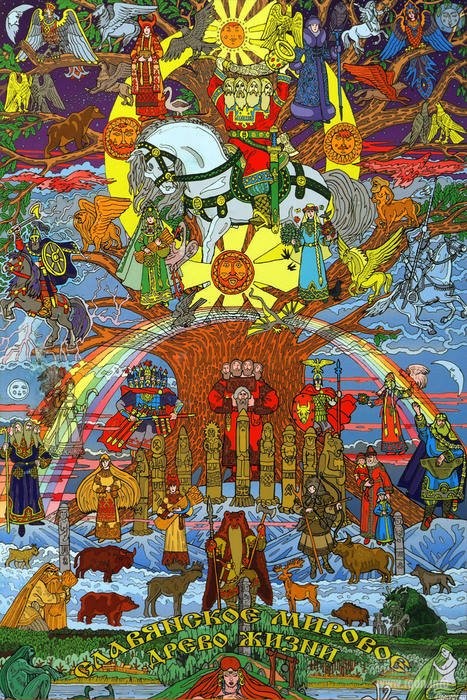
In folklore, especially in ritual songs, there are following descriptions of the World Tree: in its crown there is a nest of a nightingale (or other sacred birds: Gamayun, Sirin, Alconost, Duck, Firebird, etc.), bees carrying honey inhabit the tree trunk, an ermine lives near the roots, in the burrow (nest) there is a snake (Skurupea), and an evil spirit is chained to the tree (the last point is apparently a later addition). The World Tree fruits are seeds of all existing herbs, flowers and trees. It is traditional in the folklore to refer to the wrangle between the snake living in the roots and the bird living in the crown. The snake always threatens to burn the tree, while the bird defends itself or resorts to cunning.
The Sun and the Moon are often placed in the World Tree crown. In Belorussian folklore, beavers live near the tree roots, and a falcon lives in the crown; the tree leaves are covered with beads, flowers are like silver and fruits are of pure gold. Since it’s the World Tree, in their folklore the Slavs placed here all the most marvellous creatures, beginning with mythic birds and up to half-humans – half-horses, half-bulls, half-dogs, as well as diverse deities. They were placed near the centre of the universe.
The World Tree was so revered by the Slavs that it participated in many celebrations. A ritual tree was established prior to construction of a new house in the very middle of the construction site, thus attracting power to the site and making it sacred and having a mighty energy base. A new dwelling constructor turns his home as if in a projection of the universe centre, and the same mystic modelling of the centre takes place when the tree is brought into the house and placed in its middle or in the red corner. Another rite was collective dancing round a tree (often a birch or an oak) on solar holidays. In ancient times there were whole sacred groves and forests where it was totally forbidden to cut or damage trees. This is directly associated with the World Tree image, for sacred trees were similarly considered to be dwelling places of spirits and various creatures. In such groves and forests people arranged festivals, ceremonies, and healing rituals.
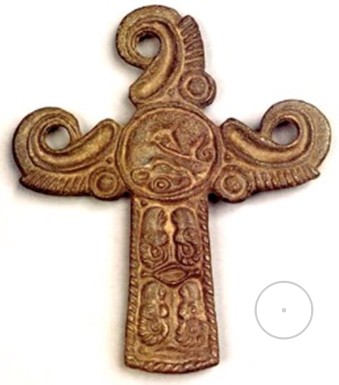
A Scythian cross from Olvia excavations

As we know, the ancient cross is a symbol of a human being, but it is also a symbol of the World Tree. At that, crosses were put on graves as a symbol of the Tree of Life, as an indicator and helper for the human soul. The World Tree is inseparably linked with man
A link between a cross and the heavenly tree is reflected in the Ethiopian writing entitled The Thirteen Cross Passions. “There is a forest land called Lithostera. People cut eight trees there and made a cross of them, seven cubits and one span in length, three cubits and one span in width. The four main trees were fig trees, the fifth was an olive, the sixth was a wild olive, the seventh was wheat, and the eighth was a reed.” Further it is told the fig tree was brought by an eagle from paradise and thrown into the Jordan River where it floated against the stream, thus showing its magic properties.
A characteristic feature draws one’s attention: the cross tree here is composed of many plants of various breeds. This may only be understood in such a way that the tree embodies fertility, thus it is regarded as a symbol of inexhaustible vital energy, perpetual renewal and revival. At that, fertility is one of significant mythological features of the World Tree. Its another characteristics, as we remember, consists in joining of different worlds, which is reflected in Christian mythology, too. For example, in the apocryphal Deeds of Apostle Andrew there is glorification of the cross, saying: “You stretch to the heaven and tell about the Supreme Word. You stretch to the right and to the left, drive dark forces away and collect the dissipated. You are strengthened in the earth and join the earthly with the heavenly... Oh, cross that is seated in the earth and brings fruits in the heaven!”
It should be added that images of a cross as a blooming evergreen tree were very popular in the Middle Ages. The ancient universal mythological image, having changed its appearance many times, became one of the favourite symbols of Christianity as the world religion.

The Cross Tree (medieval Europe)
The World Tree image was imitated in funeral ceremonies. In remote antiquity people were buried in tree branches. Later on this ceremony changed, and after cremation people’s ashes were started to be left on so-called Bdynas – posts with little huts, which were also a prototype of the World Tree and helped a deceased person both to ascent to the World of Gods and to descend to the World of People in order to visit his or her offspring. It is also known that a fir tree was a symbol of death, associated with a link, a transfer to the “other world”, and represented a necessary element of the funeral ceremony.
Since our ancestors cremated the deceased, i.e. sent them to their families, a fir tree as a resiniferous tree that could ablaze in any season was exactly used for cremation. A dead Slavic prince or princess was densely covered with fir tree branches and cones. Soothsayers performed funeral prayers, the dead body was strewed with oats or rye seeds, numerous mourners “wailed”, and the mournful fire or croda was set on fire. The burning flame rose to the sky. As it was believed, a high-rising fire (at that, cremation fires were indeed often very big) helped one’s soul to get straight into the Kingdom of the Dead. Another important attribute of the funeral ceremony was a boat, which was associated with Slavic beliefs and myths saying that in the Navi world (the World of the Dead where deceased people go and where our ancestors reside) a soul of a deceased person must cross the CurrantRiver to get directly into the place it should reach. In several legends it is mentioned that the soul crosses the river via the Guelder-RoseBridge, nonetheless dead people were burnt exactly in boats. By the way, a modern coffin is a modified and simplified boat, which was a traditional ancient funeral attribute. A priest or soothsayer set the boat on fire at sunset. The fact that cremation took place at sunset is also quite symbolical. First of all, sunset symbolized the twilight of one’s life. Secondly, according to ancient Slavic beliefs the sun leaves for the Navi underworld at night and takes the soul of a dead person along. Thirdly, it is considered that at sunset the soul can see the light of the setting sun and understand where it should go. Along the fire perimeter a fence of haystacks was laid and also set on fire. The burning fence was a fence in the sacral meaning, too, for it separated the world of the dead from the world of the living, and was an analogue of the legendary burning river in the other world. Furthermore, one’s body was burnt together with bodies of domestic or wild animals: a bird, a bear, a hare, etc., which symbolized sacrifice of one’s animal nature.
Special ritual prayers and songs were performed during cremation. Stravas (feasts in honour of the deceased), Triznas (funeral ceremonies) and combat gatherings were arranged. The rising fire meant that a person’s soul ascended to Svarga and left only its remains on the earth. When the fire burned down (or the next morning) people collected bones and ashes into a clay pot (food pot or special urn) and put it into a special “hut on the post” – an improvised little house on a big stick. Although, for instance, in northern Slavic communities they did not collect human remains, but covered the cremation place with a mound, on which a funeral ceremony was arranged. Some descriptions omit mentions of the hut and say a vessel with ashes was placed on a road post. Such huts with human remains were put on the road leading from a settlement to the west (sunset). In some regions of Russia the custom of leaving such huts on the graves was preserved until the 20th century.
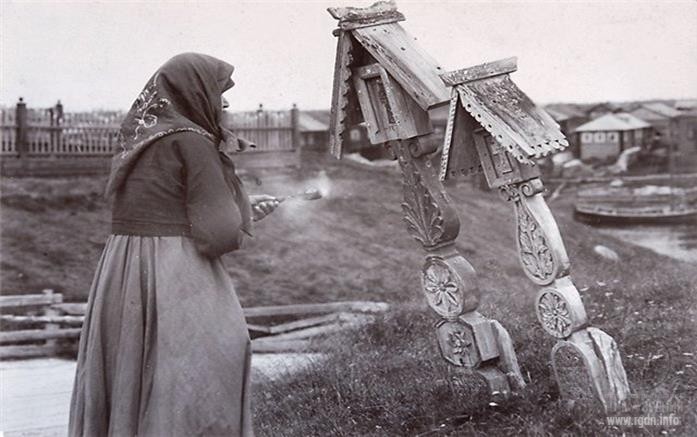
The post can also take us to the archaic past of our ancestors. Before dead bodies started to be burnt, people had been buried on trees. Such trees were a prototype of the World Tree which not only joined the world of the living and the world of the dead, but also played numerous other functions, such as support of the firmament, functions of the main axis of the universe, and so on. Later on, people began to use posts instead of trees. A post apparently continued playing the World Tree role. Via the World Tree (the post) the soul of a dead person could ascend to the world of the dead and descend back to the world of the living. It is also noteworthy that one of places where, as ancient Slavs assumed, souls went after death was the Moon. Generally speaking, the Slavs regarded planets, stars and other heavenly bodies as Gods and ancestor souls. Thus, the Milky Way was called the “road of the deceased leaving for eternal living”.
Let’s recall ancient Egyptian beliefs described in the following extract from Sensei of Shambala – Book IV by Anastasia Novykh:
“Well, if you are so interested, let’s continue… As you already know, ancient Egyptians called one of the elements Ba – the soul, which was the foundation of the Spiritual Nature. Ba was often depicted as a falcon with a human head and a lit icon-lamp in front of it, symbolizing that Ba belonged to heaven. People believed stars were a gathering of many icon-lamps of blessed Bas, souls of the Star Mother Nut.” Sensei made a pause and distinctly repeated. “Star Mother! Remember that, further you will understand why it is so important. Moreover, ancient Egyptians attributed their gods with Bas. For instance, the Orion constellation was called the soul of god Osiris. Sotis, or Sirius in our language, was the soul of goddess Isis, the faithful spouse of Osiris… Please remember it, too.”
Sensei kept silence for a while, obviously letting us better reconsider what we had just heard, and then he went on, “The second element composing the human creature according to legends of ancient Egyptians, is Akh, or it was also called Ab. Akh means ‘spirit’, ‘blessed’, ‘enlightened’, that is it originates from the Egyptian lexical root ‘akh’ – ‘to shine, to radiate’. Akh was regarded as a connecting link between the human being and the shining vital force. It was believed that after one’s death Akh left the body in order to join stars. There was even such an expression: ‘Akh goes to heaven, and body goes to earth.’
Akh was depicted as a bird with bright feathers, an ibis, which Egyptians called ‘akhu’, i.e. ‘shining’. Furthermore, in ancient Egypt they worshipped Thoth, the god of knowledge (and the bearer of divine power and soul) who was depicted as a man with an ibis head or fully as an ibis. It was believed that his wife Seshat recorded details of life of every human being on the leaves of the Tree of Heaven.”
It is also worth mentioning that ancient tribes built houses and temples in such a way that a living tree was inside, i.e. they constructed a dwelling around a tree (e.g. an oak, an ash tree, a birch). Just like idols that represented Gods on the earth, a tree inside a house was an embodiment of the World Tree, which could also join all the three worlds and be the main place for certain home rituals. Such tradition was adhered to until the beginning of the 20th century almost in the entire Russia and was preserved even thereafter in a simplified form. Before construction of a house was started, a young tree was dug up and planted in the centre or the red corner of the future house framework, and the following words were uttered: “Here is a warm house and a furry cedar for you, dear neighbour!” By the neighbour they surely meant Domovoy (the house spirit). The tree was growing there until the house was completed. Then it was taken outside and planted in a different place. At that, in ancient times such tree grew together with people, and its crown towered above the roof as if above the vault of heaven.
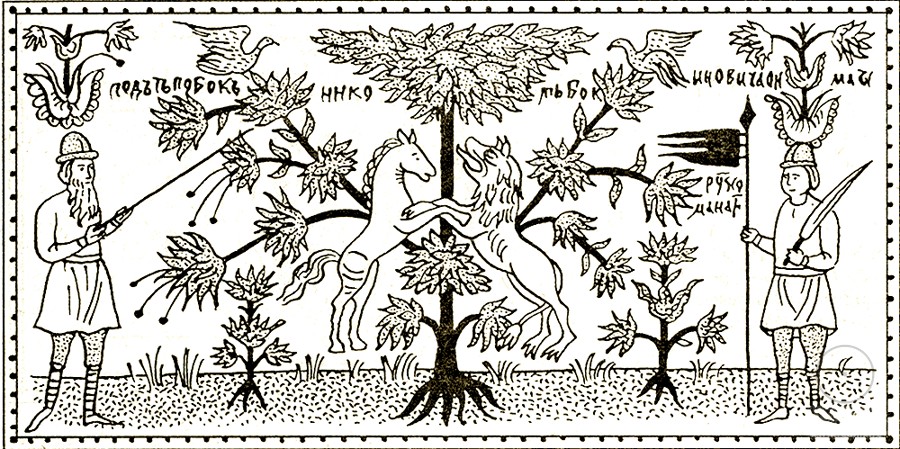
The brightest illustration of the Slavic advanced ideas of the World Tree is The Tale of Igor’s Regiment (12th century), where heathen motifs and traditions were not yet replaced with the Orthodox Christian ones. In The Tale of Igor’s Regiment the song-creator Boyan, similar to Scandinavian Odin who enjoyed the honey of poetry, undertakes a shaman journey along the World Tree:
“Boyan the prophet who wanted to create a song goes with his thought along the tree, runs as a wolf on the ground, and flies as an eagle above the clouds…”
“…jumping with his thought along the tree, flying with his mind under the clouds, maintaining the glory of both elements of that time…”
“…a virgin calls from the tree top…”
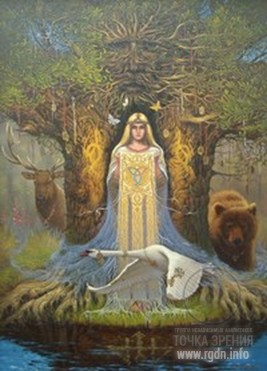
It is easy to notice the World Tree was present in all cultures. On all the continents there was the knowledge of an inseparable link of the human Soul with the Single Creator, and of the inseparable link between Allat and the World Tree concept! Thus, a person who is accumulating the Holy Spirit, residing in the Creator in every second of time, achieves Immorality, ascending on the branches of the World Tree towards its roots – to the boundless well on the bottom of which a reward is in store for him or her!

Prepared by Arbat
 The World Tree in legends and myths of peoples of the world
votes:
253
The World Tree in legends and myths of peoples of the world
votes:
253
|

Project Aim










Leave comment